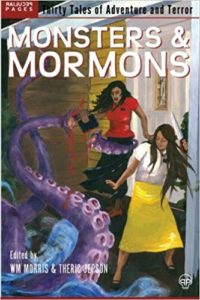 This is the third of a three-part series reviewing the last decade’s bestselling and award-winning genre novels by LDS authors. This section on speculative fiction was preceded by ones on romance novels and youth fiction.
This is the third of a three-part series reviewing the last decade’s bestselling and award-winning genre novels by LDS authors. This section on speculative fiction was preceded by ones on romance novels and youth fiction.
Speculative fiction by LDS authors in the 2010’s
Like youth fiction, Latter-day Saints have been writing speculative fiction in significant numbers since the 1980s. The numbers have been significant enough to be noted in many publications. LDS speculative authors have some cohesion, meeting together annually in the Life, The Universe & Everything conference in Utah Valley since 1983. The field was animated early on with the presence of a world-famous author, Orson Scott Card, who often included Mormon characters and themes in his work. Brandon Sanderson, who has been publishing nationally since 2005, has had nearly as much success. (Please see Liz Busby’s recent series on Mormon speculative fiction for more details on the history of the movement.)
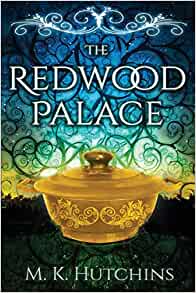 I feel less qualified to write a speculative fiction decade reviews than I did the romance and youth fiction reviews. It’s not something I read as frequently as I’ve grown older. It’s a genre that often demands the most from their readers, a suspension of disbelief, twisty plots, complicated villains, and an unflinching examination of darkness and light. So, I asked for some perspective from two writers Megan Hutchins and Joe Vasicek who are both lifelong lovers of the SFF field and active participants in the Mormon SFF community. This decade Megan wrote DRIFT, a Junior Library Guild selection, with Tu/Lee&Low, and REDWOOD PALACE with Immortal Works. Joe is a tenacious indie writer, who published his first novel GENESIS EARTH in 2011. Since then he’s published more than twenty books, the majority Science Fiction. He’s written the SONS OF THE STARFARERS series and THE GUNSLINGER TRILOGY.
I feel less qualified to write a speculative fiction decade reviews than I did the romance and youth fiction reviews. It’s not something I read as frequently as I’ve grown older. It’s a genre that often demands the most from their readers, a suspension of disbelief, twisty plots, complicated villains, and an unflinching examination of darkness and light. So, I asked for some perspective from two writers Megan Hutchins and Joe Vasicek who are both lifelong lovers of the SFF field and active participants in the Mormon SFF community. This decade Megan wrote DRIFT, a Junior Library Guild selection, with Tu/Lee&Low, and REDWOOD PALACE with Immortal Works. Joe is a tenacious indie writer, who published his first novel GENESIS EARTH in 2011. Since then he’s published more than twenty books, the majority Science Fiction. He’s written the SONS OF THE STARFARERS series and THE GUNSLINGER TRILOGY.
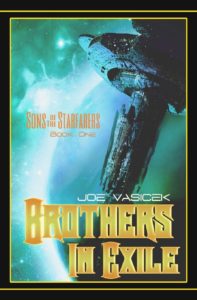 When I started out this section I expected to find Mormon SFF in a more robust state. Instead, I found that adult science fiction and fantasy was rather more eclectic and disjointed than either romance or youth fiction. Partly, because SFF is in itself a collection of minor subgenres. Secondly, as Megan explained to me, unlike romance and youth fiction, which are written almost completely as novels, understanding the adult SFF field requires looking also at short fiction and other media. Finally, independent publishing has become a major force within the genre.
When I started out this section I expected to find Mormon SFF in a more robust state. Instead, I found that adult science fiction and fantasy was rather more eclectic and disjointed than either romance or youth fiction. Partly, because SFF is in itself a collection of minor subgenres. Secondly, as Megan explained to me, unlike romance and youth fiction, which are written almost completely as novels, understanding the adult SFF field requires looking also at short fiction and other media. Finally, independent publishing has become a major force within the genre.
In 2012 the Whitney Awards had two awards and ten finalist slots for speculative fiction (Adult Speculative and Youth Speculative), and by 2019 they added a third, Youth Fantasy. AML usually does not have a separate speculative fiction category, but it sometimes honors them in its novel and short fiction awards.
The Writers of the Future short fiction contest has honored and published many Mormon writers over the years, and two Mormon writers are on the judging panel–Dave Farland and Brandon Sanderson. In addition, there are two short fiction magazines that are run largely by Mormon writers, The Leading Edge and Deep Magic. The Leading Edge is a BYU-student run magazine, publishing since 1981, and Deep Magic is an “e-zine of clean fantasy and science fiction”, which has been publishing regularly since 2016. Orson Scott Card’s Intergalactic Medicine Show was also an online short fiction magazine that existed in 2005-2019.
 Two of the most well-recognized Writer’s of the Future alumni of this decade are Eric James Stone and Brad R. Torgerson. Eric Jame Stone’s 2011 novelette “That Leviathan Whom Thou Hast Made” was a remarkable story with a Mormon science fiction setting. It was set in a future in which a Church leader has to struggle with the conversion of intelligent beings of pure plasma, called Swales, living in the heart of the sun, who have a very different culture and set of morals. The story won the Science Fiction and Fantasy Writers of America’s Nebula Award for Best Novelette and was a finalist for the World Science Fiction Society’s Hugo Award. Stone has numerous other short story credits to his name, which have been published in two collections, Rejiggering the Thingamajig and Other Stories (2011) and The Humans in the Walls and Other Stories (2020). In 2015 his short story “An Immense Darkness” was an AML short fiction finalist. In 2016 Baen published his science fiction thriller novel UNFORGETTABLE.
Two of the most well-recognized Writer’s of the Future alumni of this decade are Eric James Stone and Brad R. Torgerson. Eric Jame Stone’s 2011 novelette “That Leviathan Whom Thou Hast Made” was a remarkable story with a Mormon science fiction setting. It was set in a future in which a Church leader has to struggle with the conversion of intelligent beings of pure plasma, called Swales, living in the heart of the sun, who have a very different culture and set of morals. The story won the Science Fiction and Fantasy Writers of America’s Nebula Award for Best Novelette and was a finalist for the World Science Fiction Society’s Hugo Award. Stone has numerous other short story credits to his name, which have been published in two collections, Rejiggering the Thingamajig and Other Stories (2011) and The Humans in the Walls and Other Stories (2020). In 2015 his short story “An Immense Darkness” was an AML short fiction finalist. In 2016 Baen published his science fiction thriller novel UNFORGETTABLE.
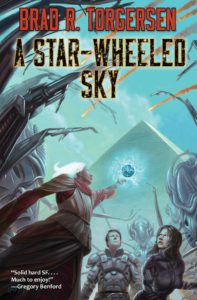 Brad Torgerson has had a very successful decade. In 2012 he was a triple Campbell, Hugo, and Nebula nominee for his short story “Ray of Light”. In 2013 his short story “The Chaplin’s Legacy”. won the Analog Award and an AML award. His novelette “Life Flight” won another Analog Award. He published a novel STAR WHEELED SKY with Baen in 2018, which won a Dragon Award for best Science Fiction Novel in 2019.
Brad Torgerson has had a very successful decade. In 2012 he was a triple Campbell, Hugo, and Nebula nominee for his short story “Ray of Light”. In 2013 his short story “The Chaplin’s Legacy”. won the Analog Award and an AML award. His novelette “Life Flight” won another Analog Award. He published a novel STAR WHEELED SKY with Baen in 2018, which won a Dragon Award for best Science Fiction Novel in 2019.
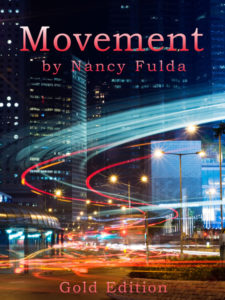 To give due recognition to women SFF short story writers: Megan Hutchins, Emily Mah and Nancy Fulda are all well recognized short story writers. Nancy Fulda was nominated for a Hugo and Nebula award for her 2011 story “Movement.” She won an AML award for 2013 story “Godshift,” and was an
To give due recognition to women SFF short story writers: Megan Hutchins, Emily Mah and Nancy Fulda are all well recognized short story writers. Nancy Fulda was nominated for a Hugo and Nebula award for her 2011 story “Movement.” She won an AML award for 2013 story “Godshift,” and was an 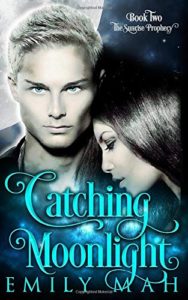 AML Short Fiction finalist in 2014 for the story “Recollection.” Emily Mah turned to indie publishing under the name Emily Mah Tippets after writing several LDS novels with Covenant Communications. She has a series of celebrity-themed contemporary romances, the first SOMEONE ELSE’S FAIRYTALE in 2013, which has been extremely successful. Most recently she’s published THE SUNRISE PROPHECY trilogy, which is paranormal romance.
AML Short Fiction finalist in 2014 for the story “Recollection.” Emily Mah turned to indie publishing under the name Emily Mah Tippets after writing several LDS novels with Covenant Communications. She has a series of celebrity-themed contemporary romances, the first SOMEONE ELSE’S FAIRYTALE in 2013, which has been extremely successful. Most recently she’s published THE SUNRISE PROPHECY trilogy, which is paranormal romance.
LDS-themed speculative fiction
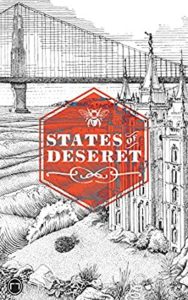 LDS authors have produced scattered examples of speculative fiction with Mormon settings for years. The 2010-2019 decade brought about a real blossoming of such literature. In 2011, the same year as Eric James Stone’s “That Leviathan Whom Thou Hast Made”, William Morris and Theric Jepson edited the multi-author short story anthology MONSTERS AND MORMONS, which celebrated the blend of Mormonism and Fantasy/Horror. William Morris went on to edit (and Jepson to publish) a second multi-author anthology, STATES OF DESERET, a collection of alternative history stories, which was an AML award finalist. Morris also published his own collection, DARK WATCH AND OTHER MORMON-AMERICAN STORIES, many of which were speculative fiction, in 2015.
LDS authors have produced scattered examples of speculative fiction with Mormon settings for years. The 2010-2019 decade brought about a real blossoming of such literature. In 2011, the same year as Eric James Stone’s “That Leviathan Whom Thou Hast Made”, William Morris and Theric Jepson edited the multi-author short story anthology MONSTERS AND MORMONS, which celebrated the blend of Mormonism and Fantasy/Horror. William Morris went on to edit (and Jepson to publish) a second multi-author anthology, STATES OF DESERET, a collection of alternative history stories, which was an AML award finalist. Morris also published his own collection, DARK WATCH AND OTHER MORMON-AMERICAN STORIES, many of which were speculative fiction, in 2015.
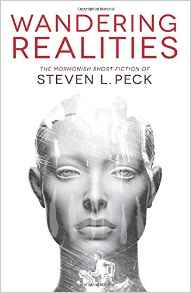 That same year Steven L. Peck, one of the most interesting Mormon authors of the decade, saw his collection, WANDERING REALITIES: MORMONISM SHORT FICTION, published by Zarahemla Press. Both Morris and Peck’s collections were finalists for AML awards. Peck’s short horror novel A SHORT STAY IN HELL (2012) is his best known work, it made so much buzz that Wandering Cut films acquired movie rights in 2013. Among Peck’s other speculative fiction
That same year Steven L. Peck, one of the most interesting Mormon authors of the decade, saw his collection, WANDERING REALITIES: MORMONISM SHORT FICTION, published by Zarahemla Press. Both Morris and Peck’s collections were finalists for AML awards. Peck’s short horror novel A SHORT STAY IN HELL (2012) is his best known work, it made so much buzz that Wandering Cut films acquired movie rights in 2013. Among Peck’s other speculative fiction 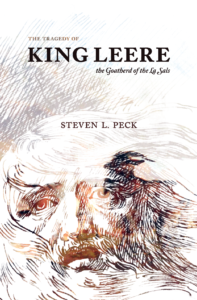 publications in the decade were the YA fantasy novel THE RIFTS OF RIME (2012), his second short fiction collection TALES FROM PLEASANT GROVE (2018), and the post-climate-change-dystopian novel THE TRAGEDY OF KING LEERE, GOATHEARD OF THE LA SALS (2019). Among his other novels, THE SCHOLAR OF MOAB (2011) received an AML Novel award and GILDA TRILLIM: SHEPHERDESS OF RATS (2017) won an AML Novel award and was a Whitney General Fiction finalist.
publications in the decade were the YA fantasy novel THE RIFTS OF RIME (2012), his second short fiction collection TALES FROM PLEASANT GROVE (2018), and the post-climate-change-dystopian novel THE TRAGEDY OF KING LEERE, GOATHEARD OF THE LA SALS (2019). Among his other novels, THE SCHOLAR OF MOAB (2011) received an AML Novel award and GILDA TRILLIM: SHEPHERDESS OF RATS (2017) won an AML Novel award and was a Whitney General Fiction finalist.
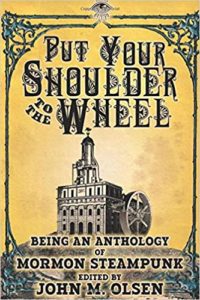 Another recent effort at LDS-themed speculative literature is the Mormon Steampunk Anthology series (2018-2019) from Immortal Works, including ALL MADE OF HINGES (edited by James Wymore), PRESS FORWARD SAINTS (edited by D. J. Butler), PUT YOUR SHOULDER TO THE WHEEL (edited by James M. Olsen) and A MIGHTY FORTRESS (edited by Holli Anderson). Immortal Works Press is a new publisher based in Salt Lake City,
Another recent effort at LDS-themed speculative literature is the Mormon Steampunk Anthology series (2018-2019) from Immortal Works, including ALL MADE OF HINGES (edited by James Wymore), PRESS FORWARD SAINTS (edited by D. J. Butler), PUT YOUR SHOULDER TO THE WHEEL (edited by James M. Olsen) and A MIGHTY FORTRESS (edited by Holli Anderson). Immortal Works Press is a new publisher based in Salt Lake City, 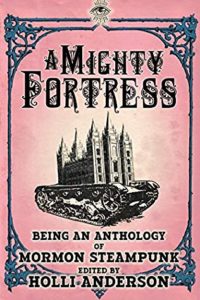 led largely by Mormons, which promotes itself as “providing high concept, quality fiction that breaks through genre tropes while keeping content PG-13 or lighter.”
led largely by Mormons, which promotes itself as “providing high concept, quality fiction that breaks through genre tropes while keeping content PG-13 or lighter.”
I know there are many more that could be recognized as talented SFF short story writers but I don’t have the mental energy or time to do that work justice. Know, however, that perhaps this is the arena that most Mormons writers make an impact as adult SFF writers.
More trends, novels, and other media
It was a tumultuous decade politically, and almost no institution was spared the cultural war that ravaged us. The SFF literary market was not spared. In 2013-2017, two LDS authors, Larry Correia and Brad A. Torgersen, helped to lead a campaign they called “Sad Puppies”, to promote certain works for nominations at the Hugo Awards. Whether fairly or unfairly, the group came to be known for supporting right-wing positions and disparaging recent attempts by other authors to push for greater diversity in the field. The controversy almost destroyed the Hugo Awards.
Around the middle of the decade, there was a decline in traditional literary careers in SFF among Mormons, perhaps because new writers have seen the declining financial rewards and elected to reject traditional and established paths to SFF literary careers. Joe Vasicek has written, “The major traditional publishing houses have been merging and consolidating for some time. After Penguin Random House acquires Simon & Schuster, they will control about 35% of the total fiction market (but I’m pretty sure this does not include indie publishers, as we tend to fly under the radar). As a direct consequence of this, traditional publishers depend a lot more on big blockbuster titles, and have all but abandoned the midlist. They are much more likely to pick up a new author with a first novel that they think will hit it big, or to put all their money into a big name author who already accounts for most of their profit. This at least partially explains why Brandon Sanderson has become such a phenomenon.”
Indeed, when I asked both Megan and Joe to name the top writers in the field aside from Sanderson, Megan argued that long-form prose fiction was too narrow a lens to understand the field. Joe pointed out the careers of two Baen Books writers D.J. (Dave) Butler and Larry Correia. Joe then gave the caveat that he feared the Baen Books (which is distributed by Simon & Schuster) would before long become another casualty of the indie revolution.
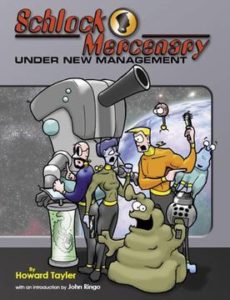 I see a lot of aspiration to create SFF in other mediums. Howard Taylor’s SCHLOCK MERCENARY webcomic received multiple Hugo and Nebula nominations. NOT A VILLAIN another webcomic by Aneeka Richins launched in 2010 and is one of the few still currently running. Aneeka also published the CHAOS GODS fantasy series this decade. Jemma M. Young was another very successful SFF webcomic writer over the decade. Her most popular work was her
I see a lot of aspiration to create SFF in other mediums. Howard Taylor’s SCHLOCK MERCENARY webcomic received multiple Hugo and Nebula nominations. NOT A VILLAIN another webcomic by Aneeka Richins launched in 2010 and is one of the few still currently running. Aneeka also published the CHAOS GODS fantasy series this decade. Jemma M. Young was another very successful SFF webcomic writer over the decade. Her most popular work was her 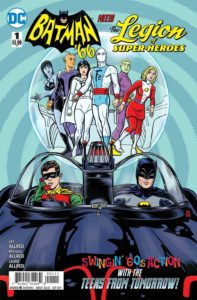 CHILDREN OF ELDAIR series. As for printed comics, Michael Allred, the creator of MADMAN and THE GOLDEN PLATES, has continued to be a leading force in the industry. He often collaborates with his wife, Laura Allred, and his brother, Lee Allred, who is also a respected speculative fiction author who has published many short stories over the decade.
CHILDREN OF ELDAIR series. As for printed comics, Michael Allred, the creator of MADMAN and THE GOLDEN PLATES, has continued to be a leading force in the industry. He often collaborates with his wife, Laura Allred, and his brother, Lee Allred, who is also a respected speculative fiction author who has published many short stories over the decade.
It appears that for many, publishing a novel is only a single step in a multi-media SFF career. It seems like the dream is to have novels, comics, blockbuster movies, TV series, games, merchandise, and podcasts based on your fictional worlds. In order to have a profitable career in SFF, one must build a multi-media corporate empire. It isn’t enough for today’s SFF writer to publish a novel once a year and expect a decent living. However, this may be too pessimistic of a take. It could simply be the result of authors becoming savvier about maximizing their own intellectual property and modern innovations make that easier now than in previous generations. Maybe it’s a positive sign that our networking structures have allowed experienced writers to mentor younger SFF in how to create multiple income streams and find creative success.
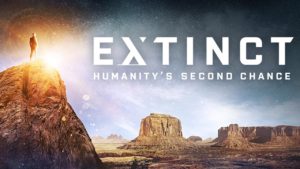 The old guard speculative writers Orson Scott Card, Tracy Hickman, and Dave Farland haven’t been as influential for their literary output this decade, and more for their teaching and writing community participation. Their releases were a tad spotty, some years very prolific other years fallow. Obviously, their writing ability is not the problem here but that the market requires more than ever for one to rely on other sources of income to survive the perils of the publishing industry. Both Hickman and Farland tried ambitious multi-media creative experiments that failed. Card did experiments with comics and other media, and was one of the primary writers along with Aaron Johnston of the BYUtv series EXTINCT. Megan believed this was the most interesting Mormon-related Adult SFF development during the decade.
The old guard speculative writers Orson Scott Card, Tracy Hickman, and Dave Farland haven’t been as influential for their literary output this decade, and more for their teaching and writing community participation. Their releases were a tad spotty, some years very prolific other years fallow. Obviously, their writing ability is not the problem here but that the market requires more than ever for one to rely on other sources of income to survive the perils of the publishing industry. Both Hickman and Farland tried ambitious multi-media creative experiments that failed. Card did experiments with comics and other media, and was one of the primary writers along with Aaron Johnston of the BYUtv series EXTINCT. Megan believed this was the most interesting Mormon-related Adult SFF development during the decade.
A movie version of Card’s most popular novel, Ender’s Game, was released in 2013, starring Harrison Ford and Asa Butterfield. The movie was a financial disappointment, just barely making enough to cover its large budget. The movie also gave a chance for Card’s critics to amplify their voices against him, especially for his public opposition to the legalization of gay marriage. The outcry included a cancellation of a planned comic he was writing for DC Comics and calls for boycott of the movie. The controversy was covered on this blog. Card has been honored with lifetime awards from both the Whitney Awards and the AML in recent years.
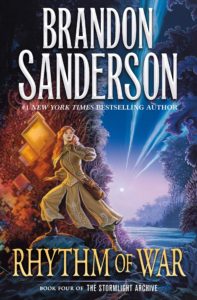 Dour pessimism aside, what Brandon Sanderson single-handedly did for the market alone is incredible. Man, Epic fantasy was out. Robert Jordan had died and it seemed like his style of storytelling was going to pass on with him. The big old epics a la Tolkien were of another era. Then Brandon Sanderson came in and literally revitalized everything. First, at the beginning of the decade, Brandon finished the Wheel of Time by Robert Jordan series fans adored and had waited ages to finish reading. Then he gave them THE WAY OF KINGS a huge, 1000 page epic fantasy that is so thick you can barely wrap your hand around the spine. It was the first of THE STORMLIGHT ARCHIVE series, to which he has added four more, icluding RHYTHM OF WAR in 2020. What a heck of a ride this writer has given all of us, from his fantasy series MISTBORN to YA novels RITHMATIST and THE RECKONERS series. He’s the male writer of the decade. Hands down. He’s taken home numerous Whitney and AML awards but I think he got the most personal satisfaction out of his Hugo awards for the novella THE EMPEROR’S SOUL (2013), as well as Hugo awards for A MEMORY OF LIGHT (2014), PERFECT STATE (2016), and THE STORMLIGHT ARCHIVE (2018).
Dour pessimism aside, what Brandon Sanderson single-handedly did for the market alone is incredible. Man, Epic fantasy was out. Robert Jordan had died and it seemed like his style of storytelling was going to pass on with him. The big old epics a la Tolkien were of another era. Then Brandon Sanderson came in and literally revitalized everything. First, at the beginning of the decade, Brandon finished the Wheel of Time by Robert Jordan series fans adored and had waited ages to finish reading. Then he gave them THE WAY OF KINGS a huge, 1000 page epic fantasy that is so thick you can barely wrap your hand around the spine. It was the first of THE STORMLIGHT ARCHIVE series, to which he has added four more, icluding RHYTHM OF WAR in 2020. What a heck of a ride this writer has given all of us, from his fantasy series MISTBORN to YA novels RITHMATIST and THE RECKONERS series. He’s the male writer of the decade. Hands down. He’s taken home numerous Whitney and AML awards but I think he got the most personal satisfaction out of his Hugo awards for the novella THE EMPEROR’S SOUL (2013), as well as Hugo awards for A MEMORY OF LIGHT (2014), PERFECT STATE (2016), and THE STORMLIGHT ARCHIVE (2018).
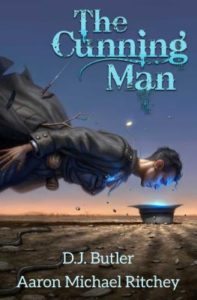 D.J. (Dave) Butler is another fantasy author that made waves this decade. His steampunk novel CITY OF SAINTS, set in an alternative 19th century “Kingdom of Deseret”, received a Whitney nomination in 2012. His middle-grade trilogy THE EXTRAORDINARY JOURNEYS OF CLOCKWORK CHARLIE was recognized with an AML nomination. His fantasy series WITCHY WAR, published with Baen, really put him on the map. The first, WITCHY EYE, was set in an alternative early United States, was honored with nominations for a Dragon and Gemmel award. The second, WITCHY WINTER won the 2018 Whitney Speculative Award and the AML Novel Award. The third book, WITCHY KINGDOM, took the 2020 Dragon award in Alternate History. He co-wrote the fantasy THE CUNNING MAN with Aaron Richey (2019), which was an AML Award finalist. It is set in Utah in the 1930s, tells the story of a Mormon “cunning man”, who has to hide his magical abilities from the surrounding society. The mix of Mormon and European folk ideas is a fascinating development in Mormon literature and reminds me of Card’s ALVIN MAKER series.
D.J. (Dave) Butler is another fantasy author that made waves this decade. His steampunk novel CITY OF SAINTS, set in an alternative 19th century “Kingdom of Deseret”, received a Whitney nomination in 2012. His middle-grade trilogy THE EXTRAORDINARY JOURNEYS OF CLOCKWORK CHARLIE was recognized with an AML nomination. His fantasy series WITCHY WAR, published with Baen, really put him on the map. The first, WITCHY EYE, was set in an alternative early United States, was honored with nominations for a Dragon and Gemmel award. The second, WITCHY WINTER won the 2018 Whitney Speculative Award and the AML Novel Award. The third book, WITCHY KINGDOM, took the 2020 Dragon award in Alternate History. He co-wrote the fantasy THE CUNNING MAN with Aaron Richey (2019), which was an AML Award finalist. It is set in Utah in the 1930s, tells the story of a Mormon “cunning man”, who has to hide his magical abilities from the surrounding society. The mix of Mormon and European folk ideas is a fascinating development in Mormon literature and reminds me of Card’s ALVIN MAKER series.
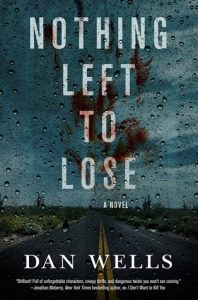 Dan Wells also had an amazing decade with his John Cleaver horror series culminating in a movie. 2009 saw him take home the Whitney for Best New Author for I AM NOT A SERIAL KILLER. In 2010 he tied with Sanderson for Whitney Best Novel of the Year with MR. MONSTER, and won that award outright for I DO NOT WANT TO KILL YOU in 2011. A stand-alone novel, THE HOLLOW CITY, took the 2012 Whitney Speculative Award. He started a second John Cleaver trilogy in 2015, and with it won a Whitney Speculative Award for THE DEVIL’S ONLY FRIEND (2015) and an AML Novel award for OVER YOUR DEAD BODY (2016). The decade also saw him write the young adult dystopian PARTIALS series and the young adult sci-fi noir MIRADOR Series. One of the Mirador books, ONES AND ZEROS (2017) won him a Whitney Young Adult Speculative award. I DON’T WANT TO KILL YOU was turned into a film in 2016, which garnered a positive response. The end of the decade saw Wells writing middle-grade fiction dramas for Audible, Amazon’s audiobook branch. He also co-hosts the Writing Excuses podcast, which gives advise to writers, with Brandon Sanderson, Mary Robinette Kowal, and Howard Tayler.
Dan Wells also had an amazing decade with his John Cleaver horror series culminating in a movie. 2009 saw him take home the Whitney for Best New Author for I AM NOT A SERIAL KILLER. In 2010 he tied with Sanderson for Whitney Best Novel of the Year with MR. MONSTER, and won that award outright for I DO NOT WANT TO KILL YOU in 2011. A stand-alone novel, THE HOLLOW CITY, took the 2012 Whitney Speculative Award. He started a second John Cleaver trilogy in 2015, and with it won a Whitney Speculative Award for THE DEVIL’S ONLY FRIEND (2015) and an AML Novel award for OVER YOUR DEAD BODY (2016). The decade also saw him write the young adult dystopian PARTIALS series and the young adult sci-fi noir MIRADOR Series. One of the Mirador books, ONES AND ZEROS (2017) won him a Whitney Young Adult Speculative award. I DON’T WANT TO KILL YOU was turned into a film in 2016, which garnered a positive response. The end of the decade saw Wells writing middle-grade fiction dramas for Audible, Amazon’s audiobook branch. He also co-hosts the Writing Excuses podcast, which gives advise to writers, with Brandon Sanderson, Mary Robinette Kowal, and Howard Tayler.
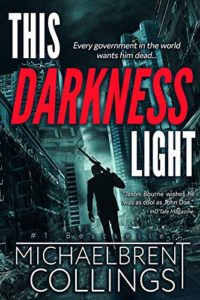 Three other Whitney recognized writer’s of horror fiction writers are David C. Belt, Michaelbrent Collings, and Mercedes M. Yardley. David C. Belt has been a finalist twice, for the paranormal novels THE PENITENT (2012) and THE ARAWN PROPHECY (2018). Michaelbrent Collings was a Whitney Award finalist for THIS DARKNESS LIGHT in 2014 and THE LONGEST CON in 2016. In 2016 his novels THE DEEP and the RIDEALONG were nominated for Bram Stoker awards. His
Three other Whitney recognized writer’s of horror fiction writers are David C. Belt, Michaelbrent Collings, and Mercedes M. Yardley. David C. Belt has been a finalist twice, for the paranormal novels THE PENITENT (2012) and THE ARAWN PROPHECY (2018). Michaelbrent Collings was a Whitney Award finalist for THIS DARKNESS LIGHT in 2014 and THE LONGEST CON in 2016. In 2016 his novels THE DEEP and the RIDEALONG were nominated for Bram Stoker awards. His 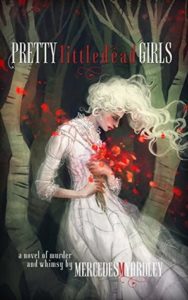 2019 SCAVENGER HUNT was a Dragon Award nominee in horror fiction. Mercedes M. Yardley received Whitney nominations for NAMELESS: THE DARKNESS COMES and PRETTY LITTLE DEAD GIRLS in 2014. Her 2015 novella LITTLE DEAD RED won the Bram Stoker award. Her short story “Loving you Darkly” was a Bram Stoker Award nominee. Her 2016 APOCALYPTIC MONTESSA AND NUCLEAR LULU: A TALE OF ATOMIC LOVE received a Stabby award from Reddit’s /r/Fantasy.
2019 SCAVENGER HUNT was a Dragon Award nominee in horror fiction. Mercedes M. Yardley received Whitney nominations for NAMELESS: THE DARKNESS COMES and PRETTY LITTLE DEAD GIRLS in 2014. Her 2015 novella LITTLE DEAD RED won the Bram Stoker award. Her short story “Loving you Darkly” was a Bram Stoker Award nominee. Her 2016 APOCALYPTIC MONTESSA AND NUCLEAR LULU: A TALE OF ATOMIC LOVE received a Stabby award from Reddit’s /r/Fantasy.
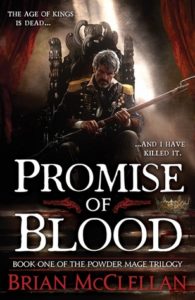 Brian McClellan studied writing under Brandon Sanderson at BYU, and won an honorable mention in the Writers of the Future contest in 2008. His POWDER MAGE trilogy, and the following GODS OF BLOOD AND POWDER series, published by Orbit are set in a fantasy world that is at the technology level of Earth at around the American Revolution and Napoleonic Wars, and are thus often called “flintlock fantasy”. His his 2014 debut novel, PROMISE OF BLOOD, won the Morningstar Award for Best Fantasy Newcomer.
Brian McClellan studied writing under Brandon Sanderson at BYU, and won an honorable mention in the Writers of the Future contest in 2008. His POWDER MAGE trilogy, and the following GODS OF BLOOD AND POWDER series, published by Orbit are set in a fantasy world that is at the technology level of Earth at around the American Revolution and Napoleonic Wars, and are thus often called “flintlock fantasy”. His his 2014 debut novel, PROMISE OF BLOOD, won the Morningstar Award for Best Fantasy Newcomer.
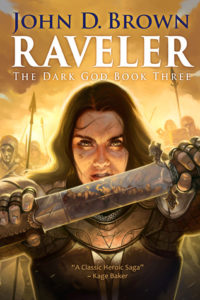 John D. Brown took the 2009 Whitney Speculative Award for SERVANT OF A DARK GOD. He had plans for a trilogy with his publisher TOR and it looked he was on track for a successful traditional publishing career. Shocking everyone, he walked away from the deal and went indie. By the end of the decade, he published 3 DARK GODS novels and 2 thrillers–BAD PENNY and AWFUL INTENT.
John D. Brown took the 2009 Whitney Speculative Award for SERVANT OF A DARK GOD. He had plans for a trilogy with his publisher TOR and it looked he was on track for a successful traditional publishing career. Shocking everyone, he walked away from the deal and went indie. By the end of the decade, he published 3 DARK GODS novels and 2 thrillers–BAD PENNY and AWFUL INTENT.
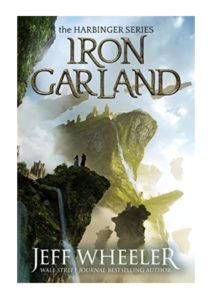 Jeff Wheeler is another author who found success outside of traditional publishing. He turned to self-publishing on Amazon and the publishing arm of Amazon scooped him right up and launched him into an extremely successful writing career on the platform. He’s launched six separate fantasy world series with multiple books in each one, including the first, MUIRWOOD the most recent THE GRAVE KINGDOM. He was a Whitney finalist in 2018 for IRON GARLAND. His success also allowed him to relaunch of his SFF e-magazine DEEP MAGIC.
Jeff Wheeler is another author who found success outside of traditional publishing. He turned to self-publishing on Amazon and the publishing arm of Amazon scooped him right up and launched him into an extremely successful writing career on the platform. He’s launched six separate fantasy world series with multiple books in each one, including the first, MUIRWOOD the most recent THE GRAVE KINGDOM. He was a Whitney finalist in 2018 for IRON GARLAND. His success also allowed him to relaunch of his SFF e-magazine DEEP MAGIC.
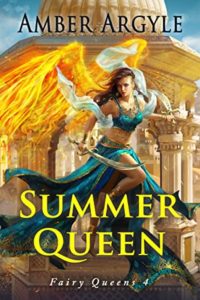 To the best of my memory, Amber Argyle was tumultuously thrown into the waters of indie publishing when her small publisher declared bankruptcy and dropped her WITCH SONG series, leaving her in a lurch. She built a strong audience on Wattpad and persisted, publishing high-quality fantasy works. Novels from her FAIRY QUEEN series have been Whitney Speculative finalists twice: WINTER QUEEN (2013), which also won a RONE award that year, and SUMMER QUEEN (2015). STOLEN ENCHANTRESS from her FORBIDDEN FOREST series was a Whitney Fantasy Young Adult finalist in 2018.
To the best of my memory, Amber Argyle was tumultuously thrown into the waters of indie publishing when her small publisher declared bankruptcy and dropped her WITCH SONG series, leaving her in a lurch. She built a strong audience on Wattpad and persisted, publishing high-quality fantasy works. Novels from her FAIRY QUEEN series have been Whitney Speculative finalists twice: WINTER QUEEN (2013), which also won a RONE award that year, and SUMMER QUEEN (2015). STOLEN ENCHANTRESS from her FORBIDDEN FOREST series was a Whitney Fantasy Young Adult finalist in 2018.
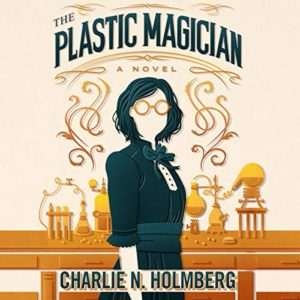 Charlie N. Holmberg, another prolific writer contracted under Amazon’s publishing arm, debuted in 2014 with THE PAPER MAGICIAN. THE GLASS MAGICIAN, also published that year, was a Whitney Young Adult Speculative finalist. She has been a finalist five other times, including FOLLOWED BY FROST, VEINS OF GOLD, THE PLASTIC MAGICIAN, and SMOKE AND SUMMONS. In 2015, THE FIFTH DOLL won the Whitney Speculative Award. Disney bought the movie rights to THE PAPER MAGICIAN, and it was on the ALA shortlist for Best Fantasy Read.
Charlie N. Holmberg, another prolific writer contracted under Amazon’s publishing arm, debuted in 2014 with THE PAPER MAGICIAN. THE GLASS MAGICIAN, also published that year, was a Whitney Young Adult Speculative finalist. She has been a finalist five other times, including FOLLOWED BY FROST, VEINS OF GOLD, THE PLASTIC MAGICIAN, and SMOKE AND SUMMONS. In 2015, THE FIFTH DOLL won the Whitney Speculative Award. Disney bought the movie rights to THE PAPER MAGICIAN, and it was on the ALA shortlist for Best Fantasy Read.
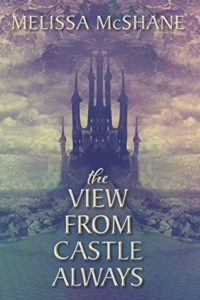 Melissa McShane is a prolific indie writer who published her first book EMISSARY in 2015, and has produced 29 books since then. Her novels have been Whitney Speculative finalists three times: ABOUNDING MIGHT and PRETENDER TO THE CROWN in 2017, and A VIEW FROM THE CASTLE ALWAYS in 2019. Melissa served as AML president in 2004-2005 (as Melissa Proffitt) and was a prolific book reviewer before she turned to writing novels.
Melissa McShane is a prolific indie writer who published her first book EMISSARY in 2015, and has produced 29 books since then. Her novels have been Whitney Speculative finalists three times: ABOUNDING MIGHT and PRETENDER TO THE CROWN in 2017, and A VIEW FROM THE CASTLE ALWAYS in 2019. Melissa served as AML president in 2004-2005 (as Melissa Proffitt) and was a prolific book reviewer before she turned to writing novels.
Josi Russell’s debut novel CARETAKER rwas a Whitney Speculative finalist in 2015. She has released five novels this decade, including one in Nick Webbs’ Legacy Fleet Universe in Kindle Worlds.
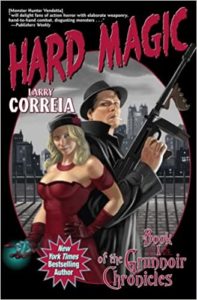 Larry Correia is an extremely popular figure in the SFF world. He is most well-known for his military fantasy MONSTER HUNTER SERIES, but also writes noir fantasy (GRIMNOIR CHRONICLES) and epic fantasy (SAGA OF THE FORGOTTEN WARRIOR series). SON OF THE BLACK SWORD (2016), the first of his epic fantasy series, won the Dragon Award for Best Fantasy novel, was an AML Novel finalist, and is probably a great way to introduce yourself to his work. Correia has received Dragon Awards for two other novels, MONSTER HUNTER MEMOIRS: GRUNGE (2017) and HOUSE OF ASSASSINS (2019). HOUSE OF ASSASSINS was also a Whitney Speculative finalist.
Larry Correia is an extremely popular figure in the SFF world. He is most well-known for his military fantasy MONSTER HUNTER SERIES, but also writes noir fantasy (GRIMNOIR CHRONICLES) and epic fantasy (SAGA OF THE FORGOTTEN WARRIOR series). SON OF THE BLACK SWORD (2016), the first of his epic fantasy series, won the Dragon Award for Best Fantasy novel, was an AML Novel finalist, and is probably a great way to introduce yourself to his work. Correia has received Dragon Awards for two other novels, MONSTER HUNTER MEMOIRS: GRUNGE (2017) and HOUSE OF ASSASSINS (2019). HOUSE OF ASSASSINS was also a Whitney Speculative finalist.
Other authors nominated for Whitney awards in Speculative Fiction include Rachel Ann Nunes IMPRINTS (2010), Theresa Sneed NO ANGEL (2011) and EARTHBOUND (2012), Jacob Gowans FLIGHT FROM BLITHMORE (2012), Stephanie Black WITNESSES (2013), Anika Arrington THE ACCIDENTAL APPRENTICE (2014), Caitlyn McFarland TRUTH OF EMBERS (2015), Sarah Beard BEYOND THE RISING TIDE (2016), Jana S Brown FALLEN STONE (2017), Christopher Husberg BLOOD REQUIEM (2018), Nicolas Petrarch AETHER SPARK (2018), Jennifer Jenkins TO KILL A CURSE (2019) Daniel Swenson A DRAGON’S FATE (2019).
The Future of Mormon-themed SFF
When I started out writing this essay I was thinking that things weren’t looking all that optimistic for SFF novels. But then I realized that three Mormon writers took Dragon Awards in 2019/2020, which is honestly a pretty awesome accomplishment. There definitely is a trend to mistrust traditional publishing and awards, which isn’t necessarily bad. The biggest downside in my mind is that it makes it much harder to find skilled writers. The advantage to having everyone going through the same pipeline was that it made them easier to identify and find. Now there is no centralized way to find our talented indie writers.
That’s why I find the Whitney Awards so interesting because they always pull one or two new writers that I hadn’t discovered before out of the dross and give us a chance to give their work a try. Monster and Mormons and other such anthologies are also excellent forums to showcase Mormon SFF work. Adult SFF does have some co-authored novels but I haven’t really seen collaborative series efforts in the same vein as youth or romance authors do. Though, perhaps I don’t have the depth of market knowledge to recognize them.
Sanderson intends to make a big investment in audiobooks this next decade so we’ll have to see if that’s where some SFF Mormon writers of the next decade show up. Perhaps indie authors will innovate ways to connect with audiences and become more visible this next decade. Immortal Works is still rather new and they have published a lot of things very quickly, which makes me a little wary. New publishing houses are fragile things. We’ll have to see how they do. Things can sometimes work out: for example Tu Publishing (started by Stacy Whitman) and Jolly Fish Press are both small publishing companies started by Mormons that were eventually bought up by larger companies. So, we’ll have to see how this small press weathers the next decade. Perhaps, it will nurture a lot of Mormon writers’ careers and bring them a good deal of success. I’m hoping for an awesome decade for everyone!

.
Whoo! That was a rush to read.
Fantastic roundup, Emily! Thanks!
1) A few other Writers of the Future contest LDS alumni included Dave Wolverton (David Farland) himself, M. Shayne Bell, Virginia Baker, John D. Brown (under “Bo Griffin” pen name — John and I were in WOTF volume 13 together), and Scott R. Parkin. I’m sure I’ve missed several.
2) Megan Hutchins is quite correct. Traditionally, the SF field is shaped as much (if not more) by short fiction as it is long form novels. The “digest magazines” like ANALOG, F&SF, ASIMOV’S etc. are the final extant vestiges of the 1920s/30s pulp magazine industry. (The mystery field has a couple digests, too — HITCHCOCK’S and ELLERY QUEEN — but their influence on the mystery field isn’t as pronounced). This is reflected in the major SF awards which not only have short form categories, but they further break down the short form by length into “novella,” “novelette,” and “short story” separate categories.
The Whitneys aren’t the best vantage point for reviewing the Mormon sf short story field (mot a knock on the Whitneys by any means; they’re designed for novels — something I’ve been acutely aware of, being primarily a short story writer). The AML does a better job monitoring us oddballs as they have short fiction and anthologies/collection awards.
Just as the rise of indie publishing has enabled more SF novels, it’s also enabled more SF short form anthologies and magazines. All of the Mormon SF anthologies mentioned in your roundup are small press/indie publications. I remember sitting down with Jack Lyons of Deseret Books in the 1990s a few times trying to promote an anthology of Mormon sf short stories, but the cold equations of traditional publishing P&L couldn’t justify it then or, I suspect, now even.
Current indie publishing technology has allowed a good number of Mormon lit SF anthologies, William Morris’ STATES OF DESERET being the most significant in my opinion, with MONSTERS & MORMONS being a close second. The four Mormon steampunk volumes by Immortal Press mentioned in your round up are great frothy pulpy fun; their big achievement was devoting so much space and effort to such a tiny sub-sub-genre. They didn’t create MoSteampunk, but they certainly jumpstarted it, for which I’m very grateful. I was able in my two IW entries to nail down a fictional universe I’ll be basing some long form projects on.
Not mentioned in your round up was the noteworthy MEETINGS OF THE MYTHS 2014 edition of the annual MORMON LIT BLITZ online flash fiction contest. While the regular annual Blitz contests welcomes SF genre stories (I’ve had a couple finalists in regular years), the MOTM version was completely sf/fantasy/horror genre — and they doubled the usual word count permissible to 2000 words, nearly upping it into regular short story length.
Even with these noteworthy short form publications, Mormon market short story venues are still rather few and far between. I jump at just about every one I hear about, but much of my overtly Mormon short form output has been published in national market venue. (“For the Strength of the Hills,” “Hymnal,” and “The Curious Case of The Ha’penny Detective” for example.) We could do with more anthology projects, imo.
One last short form observation: although not wholly SFnal, William Morris’ excellent DARK WATCH AND OTHER MORMON-AMERICAN STORIES collection deserves a place in any list of Mormon SF in the 2010s. Several of Morris’ SF stories — “PIAH” and “The Release” in particular — are even more relevant and resonant now in 2021 than they were in when they first appeared in print.
Great roundup, Emily. 🙂 I attempted a long comment about SF short stories in general and LDS short stories in particular, but my comment seems to have wandered off into the aether, wherever electrons go to die. If it doesn’t show up, I’ll attempt it again.
Lee:
I’m delighted you remember “PAIH” (praying always in heart). It’s one of the things I’ve written that I’m most proud of.
I should have more Mormon speculative fiction (some SF some more… speculative) coming out this year.
Doh! Messed up on the acronym. PAIH. PAIH. PAIH. My fingers need a reboot and a software reinstall. (Looking forward to more of your fiction, Wm. Great news!)